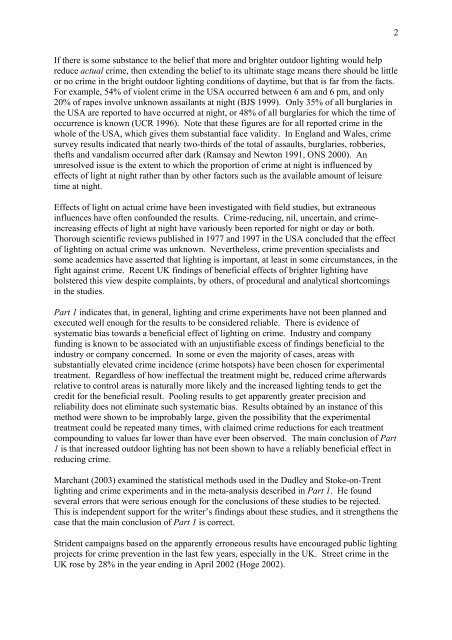Outdoor Lighting and Crime - Amper
Outdoor Lighting and Crime - Amper
Outdoor Lighting and Crime - Amper
Create successful ePaper yourself
Turn your PDF publications into a flip-book with our unique Google optimized e-Paper software.
If there is some substance to the belief that more <strong>and</strong> brighter outdoor lighting would help<br />
reduce actual crime, then extending the belief to its ultimate stage means there should be little<br />
or no crime in the bright outdoor lighting conditions of daytime, but that is far from the facts.<br />
For example, 54% of violent crime in the USA occurred between 6 am <strong>and</strong> 6 pm, <strong>and</strong> only<br />
20% of rapes involve unknown assailants at night (BJS 1999). Only 35% of all burglaries in<br />
the USA are reported to have occurred at night, or 48% of all burglaries for which the time of<br />
occurrence is known (UCR 1996). Note that these figures are for all reported crime in the<br />
whole of the USA, which gives them substantial face validity. In Engl<strong>and</strong> <strong>and</strong> Wales, crime<br />
survey results indicated that nearly two-thirds of the total of assaults, burglaries, robberies,<br />
thefts <strong>and</strong> v<strong>and</strong>alism occurred after dark (Ramsay <strong>and</strong> Newton 1991, ONS 2000). An<br />
unresolved issue is the extent to which the proportion of crime at night is influenced by<br />
effects of light at night rather than by other factors such as the available amount of leisure<br />
time at night.<br />
Effects of light on actual crime have been investigated with field studies, but extraneous<br />
influences have often confounded the results. <strong>Crime</strong>-reducing, nil, uncertain, <strong>and</strong> crimeincreasing<br />
effects of light at night have variously been reported for night or day or both.<br />
Thorough scientific reviews published in 1977 <strong>and</strong> 1997 in the USA concluded that the effect<br />
of lighting on actual crime was unknown. Nevertheless, crime prevention specialists <strong>and</strong><br />
some academics have asserted that lighting is important, at least in some circumstances, in the<br />
fight against crime. Recent UK findings of beneficial effects of brighter lighting have<br />
bolstered this view despite complaints, by others, of procedural <strong>and</strong> analytical shortcomings<br />
in the studies.<br />
Part 1 indicates that, in general, lighting <strong>and</strong> crime experiments have not been planned <strong>and</strong><br />
executed well enough for the results to be considered reliable. There is evidence of<br />
systematic bias towards a beneficial effect of lighting on crime. Industry <strong>and</strong> company<br />
funding is known to be associated with an unjustifiable excess of findings beneficial to the<br />
industry or company concerned. In some or even the majority of cases, areas with<br />
substantially elevated crime incidence (crime hotspots) have been chosen for experimental<br />
treatment. Regardless of how ineffectual the treatment might be, reduced crime afterwards<br />
relative to control areas is naturally more likely <strong>and</strong> the increased lighting tends to get the<br />
credit for the beneficial result. Pooling results to get apparently greater precision <strong>and</strong><br />
reliability does not eliminate such systematic bias. Results obtained by an instance of this<br />
method were shown to be improbably large, given the possibility that the experimental<br />
treatment could be repeated many times, with claimed crime reductions for each treatment<br />
compounding to values far lower than have ever been observed. The main conclusion of Part<br />
1 is that increased outdoor lighting has not been shown to have a reliably beneficial effect in<br />
reducing crime.<br />
Marchant (2003) examined the statistical methods used in the Dudley <strong>and</strong> Stoke-on-Trent<br />
lighting <strong>and</strong> crime experiments <strong>and</strong> in the meta-analysis described in Part 1. He found<br />
several errors that were serious enough for the conclusions of these studies to be rejected.<br />
This is independent support for the writer’s findings about these studies, <strong>and</strong> it strengthens the<br />
case that the main conclusion of Part 1 is correct.<br />
Strident campaigns based on the apparently erroneous results have encouraged public lighting<br />
projects for crime prevention in the last few years, especially in the UK. Street crime in the<br />
UK rose by 28% in the year ending in April 2002 (Hoge 2002).<br />
2
















